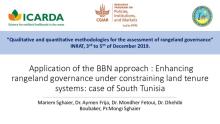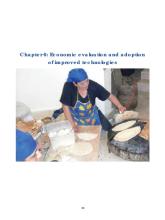/ library resources
Showing items 82 through 90 of 376.The Economics of Land Degradation (ELD) initiative seeks to develop a
science basis for policy actions to address land degradation. The purpose of this
chapter is to provide with a conceptual framework and sound and feasible
ICARDA witnessed several important developments in 2006.
Neighbourhood effects on land use change are very common. Therefore, they are often
included in spatially explicit models of land use change and other spatial analyses. Neighbourhood
indices, however, depend strongly on the spatial extent set for calculating them. So far, most of the
Presentation on Measurement of the Costs of Land Degradation in the Mountains of the Republic of Tajikistan delivered during the CACIP Regional Consultation Meeting held in Dushanbe, Tajikistan.
This report will focus on results of 2004/05 and 2005/06 seasons in which the conventional handmade microcatchment was compared to the mechanized one through research done at the Jordan University of Science and Technology site.
The presentation discusses the application of the Bayesian Belief Network (BBN) approach to enhance rangeland governance under constraining land tenure systems in the South of Tunisia.
In this study, an economic evaluation of water-use efficiency technologies proposed and tested by the agronomic team in the Tadla Irrigated Perimeter was carried out. To capture climatic variability, the analysis was conducted during two contrasting years (dry and wet).
The Jordan Badia is representative of the vast drier environments of the West Asia and North Africa (WANA) region. Pasture rangeland covers the majority of the Badia, although the vegetative cover is not dense. The vegetation in the Badia includes shrubs and short grasses.
The new lands are represented by the El- Bustan area. The soils of the site are mostly sandy with low fertility and relatively low water holding capacity and crops are grown exclusively under irrigation using modern irrigation systems.
Paginação
Land Library Search
Through our robust search engine, you can search for any item of the over 73,000 highly curated resources in the Land Library.
If you would like to find an overview of what is possible, feel free to peruse the Search Guide.









